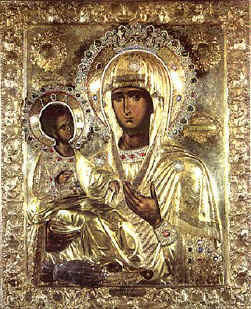About this CalendarGrace to you and peace. Because most devotions to Mary, Mother of Jesus, are associated with the Catholic or Orthodox Churches, their public celebrations cluster around Sundays and liturgical feast days of those churches, such as January 1 (Mother of God), February 2 (Purification), March 25 (Annunciation), May 31 (Visitation), Easter, Pentecost, July 2 (Visitation, formerly), August 15 (Assumption), September 8 (her Nativity), October 7 (Rosary), November 21 (Presentation), and December 8 (Immaculate Conception). Also, since in many communities the Madonna's celebration is a major event, drawing pilgrims from a wide area and providing the occasion for public festivities, it tends to fall on a weekend in good weather. So in devising a calendar with a different Marian celebration for each date, it's necessary to use anniversary dates of associated events, such as apparitions, miracles, foundations, dedications, and the "crowning" of images by Catholic officials, which may or may not get annual notice by devotees. The result is a presentation of devotions to Mary moved from their moorings in place and time to the omnipresent, to a recurrent now that could be anywhere, appropriate to the "virtual" situation in which you are invited to visit them. To do this is perhaps to sacrifice some meaning, with the hope that in the transfer of context some new meaning may emerge, or, at least, some new delight in joining traditions across centuries and continents. |
Mother of God of Three Hands, Mt. Athos, Greece |
|
When I started this project, I hoped to correct errors being propagated by similar online calendars. Some had roots in books such as Catholic Gems or Treasures of the Church by Francis Deligny, S.J., and John Gilmary Shea, LLD (1887) and The Woman in Orbit by Manetta Lamberty, S.C.C. (1966), well-researched works whose authors occasionally assigned undated devotions to gaps in the calendar as needed. As they were reproduced and revised in print and then online, such Marian calendars acquired garbled place names and other anomalies in addition to spurious dates, mutating like phrases in a game of gossip as they perked through the web. Over ten years later, I realize that my contribution has become part of this process. Like the people that support them, devotions change. As they move from fishing and agriculture to a wage-based economy, communities often move their celebrations from fixed dates to weekends and holidays. New devotions, increasing secularism, and the depopulation of villages sometimes cause the complete decline of older traditions -- which live on in websites like this one. In 2008, shrines and towns did not always have their own websites. Now, it's much easier to get first-hand news of far-flung places and to translate it if necessary. As I work to revise these pages and improve their accuracy, they too have been propagated online, notably by 365 Days with Mary, mariancalendar.org; and AVE MARIA!, immaculate.one (in both English and Italian). Such is the way of the web. With apologies for any mistakes I've helped spread, I still hope that the benefits of this transmission outweigh the pitfalls. Additions and corrections are welcome. Mary Ann Daly |
|
